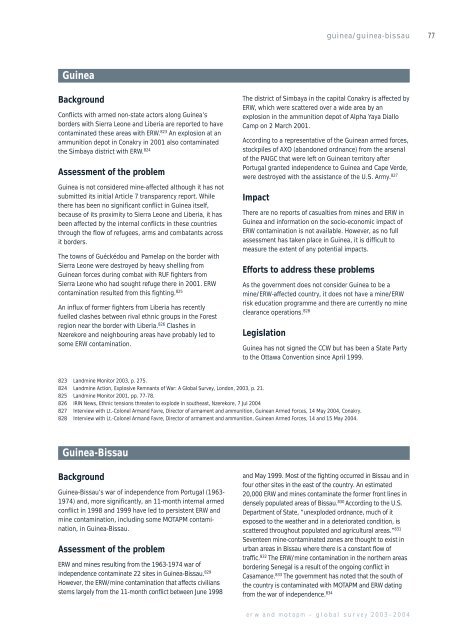Country & Territory Reports - Landmine Action
Country & Territory Reports - Landmine Action
Country & Territory Reports - Landmine Action
You also want an ePaper? Increase the reach of your titles
YUMPU automatically turns print PDFs into web optimized ePapers that Google loves.
Guinea<br />
Background<br />
Conflicts with armed non-state actors along Guinea’s<br />
borders with Sierra Leone and Liberia are reported to have<br />
contaminated these areas with ERW. 823 An explosion at an<br />
ammunition depot in Conakry in 2001 also contaminated<br />
the Simbaya district with ERW. 824<br />
Assessment of the problem<br />
Guinea is not considered mine-affected although it has not<br />
submitted its initial Article 7 transparency report. While<br />
there has been no significant conflict in Guinea itself,<br />
because of its proximity to Sierra Leone and Liberia, it has<br />
been affected by the internal conflicts in these countries<br />
through the flow of refugees, arms and combatants across<br />
it borders.<br />
The towns of Guéckédou and Pamelap on the border with<br />
Sierra Leone were destroyed by heavy shelling from<br />
Guinean forces during combat with RUF fighters from<br />
Sierra Leone who had sought refuge there in 2001. ERW<br />
contamination resulted from this fighting. 825<br />
An influx of former fighters from Liberia has recently<br />
fuelled clashes between rival ethnic groups in the Forest<br />
region near the border with Liberia. 826 Clashes in<br />
Nzerekore and neighbouring areas have probably led to<br />
some ERW contamination.<br />
The district of Simbaya in the capital Conakry is affected by<br />
ERW, which were scattered over a wide area by an<br />
explosion in the ammunition depot of Alpha Yaya Diallo<br />
Camp on 2 March 2001.<br />
According to a representative of the Guinean armed forces,<br />
stockpiles of AXO (abandoned ordnance) from the arsenal<br />
of the PAIGC that were left on Guinean territory after<br />
Portugal granted independence to Guinea and Cape Verde,<br />
were destroyed with the assistance of the U.S. Army. 827<br />
Impact<br />
There are no reports of casualties from mines and ERW in<br />
Guinea and information on the socio-economic impact of<br />
ERW contamination is not available. However, as no full<br />
assessment has taken place in Guinea, it is difficult to<br />
measure the extent of any potential impacts.<br />
Efforts to address these problems<br />
As the government does not consider Guinea to be a<br />
mine/ERW-affected country, it does not have a mine/ERW<br />
risk education programme and there are currently no mine<br />
clearance operations. 828<br />
Legislation<br />
guinea/guinea-bissau 77<br />
Guinea has not signed the CCW but has been a State Party<br />
to the Ottawa Convention since April 1999.<br />
823 <strong>Landmine</strong> Monitor 2003, p. 275.<br />
824 <strong>Landmine</strong> <strong>Action</strong>, Explosive Remnants of War: A Global Survey, London, 2003, p. 21.<br />
825 <strong>Landmine</strong> Monitor 2001, pp. 77-78.<br />
826 IRIN News, Ethnic tensions threaten to explode in southeast, Nzerekore, 7 Jul 2004<br />
827 Interview with Lt.-Colonel Armand Favre, Director of armament and ammunition, Guinean Armed Forces, 14 May 2004, Conakry.<br />
828 Interview with Lt.-Colonel Armand Favre, Director of armament and ammunition, Guinean Armed Forces, 14 and 15 May 2004.<br />
Guinea-Bissau<br />
Background<br />
Guinea-Bissau’s war of independence from Portugal (1963-<br />
1974) and, more significantly, an 11-month internal armed<br />
conflict in 1998 and 1999 have led to persistent ERW and<br />
mine contamination, including some MOTAPM contamination,<br />
in Guinea-Bissau.<br />
Assessment of the problem<br />
ERW and mines resulting from the 1963-1974 war of<br />
independence contaminate 22 sites in Guinea-Bissau. 829<br />
However, the ERW/mine contamination that affects civilians<br />
stems largely from the 11-month conflict between June 1998<br />
and May 1999. Most of the fighting occurred in Bissau and in<br />
four other sites in the east of the country. An estimated<br />
20,000 ERW and mines contaminate the former front lines in<br />
densely populated areas of Bissau. 830 According to the U.S.<br />
Department of State, “unexploded ordnance, much of it<br />
exposed to the weather and in a deteriorated condition, is<br />
scattered throughout populated and agricultural areas.” 831<br />
Seventeen mine-contaminated zones are thought to exist in<br />
urban areas in Bissau where there is a constant flow of<br />
traffic. 832 The ERW/mine contamination in the northern areas<br />
bordering Senegal is a result of the ongoing conflict in<br />
Casamance. 833 The government has noted that the south of<br />
the country is contaminated with MOTAPM and ERW dating<br />
from the war of independence. 834<br />
erw and motapm – global survey 2003–2004


